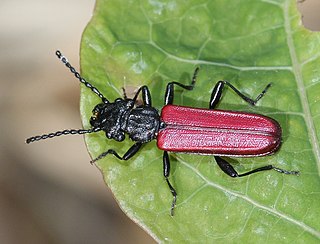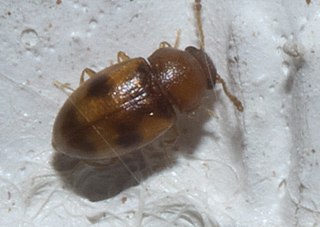
Cryptophagidae is a family of beetles with representatives found in all biogeographic realms. Members of this family are commonly called silken fungus beetles and both adults and larvae appear to feed exclusively on fungi although in a wide variety of habitats and situations, such as rotting wood and shed animal fur and feathers. These beetles vary from about 1 to 11 millimeters long, and usually have an oval body shape with a slight "waist".

Erotylidae, or the pleasing fungus beetles, is a family of beetles belonging to Cucujoidea containing over 100 genera. In the present circumscription, it contains 6 tribes and 10 subfamilies. In other words, the narrowly circumscribed Erotylidae correspond to the subfamily Erotylinae in the definition sensu lato. There are doubts on the monophyly of lower ranked taxa within Erotylidae, with further phylogenetic studies requiring better sampling and studies of unexplored character sets, for example the metendosternite and penile flagellum, which are generally lacking detailed morphological studies within the Coleoptera literature. The Eroytlina taxonomy is based on traits such as their different colors and not off morphological differences like mouthparts, thorax, and abdominal terminalia (Pecci-Maddalena).

Cucujus is a genus of beetles in the family Cucujidae, the flat bark beetles. It contains 19 currently recognized species and subspecies.

Laemophloeidae, "lined flat bark beetles," is a family in the superfamily Cucujoidea characterized by predominantly dorso-ventrally compressed bodies, head and pronotal discs bordered by ridges or grooves, and inverted male genitalia. Size range of adults is 1–5 mm (0.04–0.2 in) in length. Currently, it contains 40 genera and about 450 species, and is represented on all continents except Antarctica; species richness is greatest in the tropics.

Silvanidae, "silvan flat bark beetles", is a family of beetles in the superfamily Cucujoidea, consisting of 68 described genera and about 500 described species. The family is represented on all continents except Antarctica, and is most diverse at both the generic and species levels in the Old World tropics.

Laemophloeus is a genus of beetles; it is the type genus of the family Laemophloeidae. The genus has been almost completely reviewed in modern times.

Monotomidae is a family of beetles in the superfamily Cucujoidea. The family is found worldwide, with approximately 240 species in 33 genera. The ecological habits of the family are diverse, with different members of the group being found under tree bark, in decaying vegetation, on flowers and in ant nests. Their ecology is obscure, while at least some species are mycophagous, feeding on the fruiting bodies of ascomycete fungi, Rhyzophagus are predators on bark beetles and possibly Phoridae larvae, with the larvae of some species also being mycophagous.
Bactridium is a genus of root-eating beetles in the family Monotomidae. There are about 18 described species in Bactridium.

Toramus is a genus of pleasing fungus beetles in the family Erotylidae. There are about nine described species in Toramus.

Languria is a genus of lizard beetles in the family Erotylidae. There are about 18 described species in Languria.

Xenoscelinae is a subfamily of pleasing fungus beetles in the family Erotylidae. There are about 8 genera and 12 described species in Xenoscelinae.

Pharaxonotha is a genus of pleasing fungus beetles in the family Erotylidae. There are at least three described species in Pharaxonotha.

Loberus is a genus of pleasing fungus beetles in the family Erotylidae. There are about 16 described species in Loberus.

Caenoscelis is a genus of silken fungus beetles in the family Cryptophagidae. There are about 19 described species in Caenoscelis.

Cyllodes is a genus of sap-feeding beetles in the family Nitidulidae. There are about 14 described species in Cyllodes.

Cryptophilus integer is a species of pleasing fungus beetle in the family Erotylidae. It is found in Australia, Europe and Northern Asia, North America, and Oceania.
Hapalips is a genus of pleasing fungus beetles in the family Erotylidae. There are about 12 described species in Hapalips.

Dacne is a genus of pleasing fungus beetles in the family Erotylidae. There are about 19 described species in Dacne.
Langurites is a genus of lizard beetles in the family Erotylidae. There are at least three described species in Langurites.

Myrabolia is the only genus in the beetle family Myraboliidae in the superfamily Cucujoidea. It has about 13 species, found in Australia. Adults and possibly larvae live under the bark of Eucalyptus trees.















